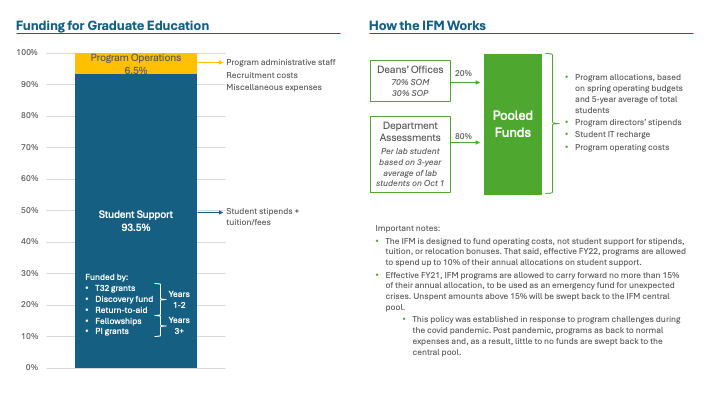The Integrated Funding Model (IFM) is the mechanism by which SOM, SOP, departments, and organized research units (ORUs) contribute to the operating costs of nine basic science graduate programs at UCSF: Bioengineering, Biological and Medical Informatic (BMI), Biomedical Sciences (BMS), Biophysics Program (BP), Chemistry and Chemical Biology (CCB), Developmental & Stem Cell Biology (DSCB), Neuroscience, Pharmaceutical Sciences and Pharmacogenomics (PSPG), and Tetrad.
IFM Overview

Historical Background
The IFM was initiated in fall 2010 to address graduate programs' financial operating needs, e.g., program staff, activities, retreats, recruitment, etc.
-
Before the IFM, operating costs were covered in an ad hoc manner.
-
Significant support came from a limited number of departments. Many departments did not contribute to cover operating costs, though students were conducting research in their labs.
-
There was occasional help from departments, institutes, and deans to support specific costs and programs.
Who Contributes to the IFM?
-
Departments and units where students do their thesis research; generally, ~33 departments, ORUs, institutes and centers. A three-year historical lab student average is used to determine assessments. Contributions from departments make-up ~80% of total IFM funding.
-
Deans' Offices (SOM and SOP): The remaining ~20% of the annual contributions come from the SOM and SOP Dean’s Offices.
How Much Programs Receive
-
Each program's annual allocation is based on two factors:
-
Annual program operating budget, with inflation; and
-
Adjusted based on increases or decreases in the five-year average historical graduate student enrollment.
-
Operational Budgets
- In general, program operating budgets may include the following items:
- Program staff payroll
- A portion of departmental staff payroll who support the program, e.g., CAO, finance manager, analyst, etc.
- Administration expenses, e.g., telephone, data network recharge, mail/postage, copies, office supplies, etc.
- Program activities, e.g., formal seminars, journal clubs, student/faculty talks, orientation/welcome event, grant writing workshops, tutoring, etc.
- Recruitment activity, e.g., retreats, travel, meetings, entertainment, etc.
- Any one-time programmatic expense
Annual Budget & Review Timeline
October – Student Data Collection
Student data is collected from the graduate program administrators to produce an accurate list of all students enrolled as of end of September in the current year.
-
Students should appear in the PI’s home department as the methodology charges departments by PI.
-
The IFM is not connected to the Educational Technology or the Oral and Craniofacial Sciences (OCS) programs.
January – Directors' Stipends
IFM directors’ stipend payments are usually processed as a lump sum each year. The annual stipend amount is provided by the Student Academic Affairs office, usually after they verify the fall quarter enrollment.
Early February – IFM Budget Call
Request for programs' operating budgets for the next fiscal year, typically due one month later.
Early March – IFM Forecast & Plan
Programs complete current year forecast and plan for next year for employee and general planning on Project 1000101. The program’s budget is rolled up to the consolidated IFM budget for the Graduate Student Funding Committee’s review. Budget data are extracted from PLUS.
Late April – Graduate Student Funding Committee Review
Meeting to approve next year’s assessments and allocations.
-
Reminder that PI-owed funds should not be covering the IFM department expenses.
-
Forms should be updated with the department-funded chartstring(s).
Financial Activities Timeline
July – IFM Close-Out Process
Deficit clean-up; deficits removed from Project 1000101. [Could add a link to fiscal close page/ calendar]
August – First Installment of IFM Contributions
Journals prepared in first half of August
January – Second Installment of IFM Contributions
Journals prepared in second half of January
